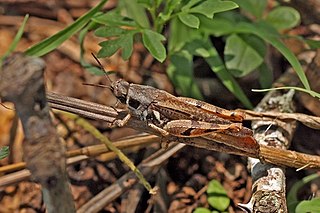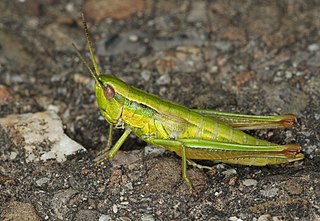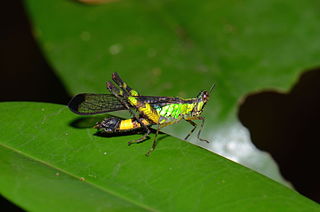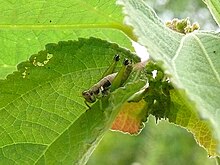
The subfamily Catantopinae is a group of insects classified under family Acrididae. Genera such as Macrotona may sometimes called "spur-throated grasshoppers", but that name is also used for grasshoppers from other subfamilies, including the genus Melanoplus from the Melanoplinae.

Bandwings, or band-winged grasshoppers, are the subfamily Oedipodinae of grasshoppers classified under the family Acrididae. They have a worldwide distribution and were originally elevated to full family status as the Oedipodidae. Many species primarily inhabit xeric weedy fields, and some are considered to be important locusts:

The grasshopper subfamily Acridinae, sometimes called silent slant-faced grasshoppers, belong of the large family Acrididae in the Orthoptera: Caelifera.

The Caelifera are a suborder of orthopteran insects. They include the grasshoppers and grasshopper-like insects, as well as other superfamilies classified with them: the ground-hoppers (Tetrigoidea) and pygmy mole crickets (Tridactyloidea). The latter should not be confused with the mole crickets (Gryllotalpidae), which belong to the other Orthopteran sub-order Ensifera.

Gomphocerinae, sometimes called "slant-faced grasshoppers", are a subfamily of grasshoppers found on every continent but Antarctica and Australia.

Pyrgomorphidae is a family of grasshoppers in the order Orthoptera; it is the only family in the superfamily Pyrgomorphoidea. Pyrgomorphidae is found worldwide in tropical and warm temperate regions, but the vast majority of the family's approximately 500 species are from Africa, Asia and Australia. Their name is probably derived from pyrgos meaning "tower": a reference to the form (morph) of the head in the type genus Pyrgomorpha and other genera.

Eumastacidae are a family of grasshoppers sometimes known as monkey- or matchstick grasshoppers. They usually have thin legs that are held folded at right angles to the body, sometimes close to the horizontal plane. Many species are wingless and the head is at an angle with the top of the head often jutting above the line of the thorax and abdomen. They have three segmented tarsi and have a short antenna with a knobby organ at the tip. They do not have a prosternal spine or tympanum. Most species are tropical and the diversity is greater in the Old World. They are considered primitive within the Orthoptera and feed on algae, ferns and gymnosperms, the more ancient plant groups.

Eumastacoidea is a superfamily within the order Orthoptera, suborder Caelifera. The family has a mainly tropical distribution and have sometimes been called "monkey grasshoppers".

Chorotypidae is a family of tropical Asian grasshoppers, formerly included within the family Eumastacidae. These grasshoppers have a head that rises above the level of the thorax and short antennae. Some species have reduced wings, others have wings that widen towards the tips and still others have a flattened leaf-like shape. They lack abdominal tympani.

Pamphagidae is a family of grasshoppers belonging to the superfamily Acridoidea. The species in this family can be found in Africa, Europe and Asia.

Acrididea including the Acridomorpha is an infraorder of insects that describe the grasshoppers and ground-hoppers. It contains a large majority of species in the suborder Caelifera and the taxon Acridomorpha may also be used, which excludes the Tetrigoidea. Both names are derived from older texts, such as Imms, which placed the "short-horned grasshoppers" and locusts at the family level (Acrididae). The study of grasshopper species is called acridology.

Erianthus is a genus of grasshoppers restricted to Southeast Asia. They occur in Japan, northeast India, Myanmar, Thailand, Vietnam, South China including Hong Kong, and extend east to Sumatra. In the past some neotropical species were also included in the genus. They have narrow ranges and species are identifiable only by their characteristics of male and female genitalia.

The Hemiacridinae are a subfamily of Acrididae in the Orthoptera: Caelifera. Species can be found in Africa and Asia.

Romaleinae is a subfamily of lubber grasshoppers in the family Romaleidae, found in North and South America. More than 60 genera and 260 described species are placed in the Romaleinae.

Pyrgomorpha is the type genus of grasshoppers in the family Pyrgomorphidae and the tribe Pyrgomorphini. Species are found in Southern Europe, Africa and the middle East, through to India and Mongolia.

The Orthacridinae are a sub-family of grasshoppers in the family Pyrgomorphidae. Species are found in: Central America, Africa, Asia, Australia and certain Pacific Islands. The type genus is Orthacris and the taxon proposed by Bolívar in 1905.
China is a genus of grasshoppers in the family Chorotypidae. As of 2018, it is monospecific, consisting of its sole species China mantispoides. It is found in China, Thailand, and Myanmar. Malcolm Burr first circumscribed the genus in 1899; the species C. mantispoides was described in 1870 by Francis Walker. It is a pest of hickory trees.

The Erianthinae are a subfamily of Asian grasshoppers in the family Chorotypidae and based on the type genus Erianthus. There are currently 12 genera and more than 40 described species recorded from southern China, Japan, Indo-China and Malesia.
Stenerianthus annamensis is a species of grasshopper in the monotypic genus Stenerianthus. It is in the family Chorotypidae, subfamily Erianthinae. This "monkey grasshopper" was discovered in central Vietnam, with the type locality identified as "Lien Chien" near Da Nang.

The Ommatolampidinae are a subfamily of grasshoppers in the family Acrididae, found in central and South America, and based on the type genus Ommatolampis. Derived from the "Ommatolampides" used by Brunner von Wattenwyl in 1893, the first use of the name in its current form was by Rodríguez et al. in 2013; this taxon appears to be paraphyletic.


















